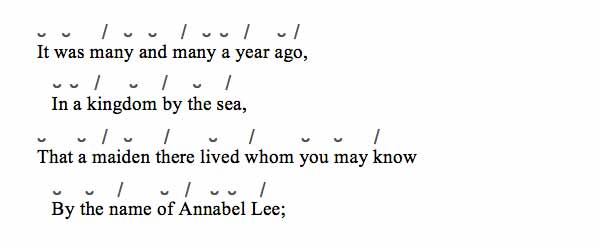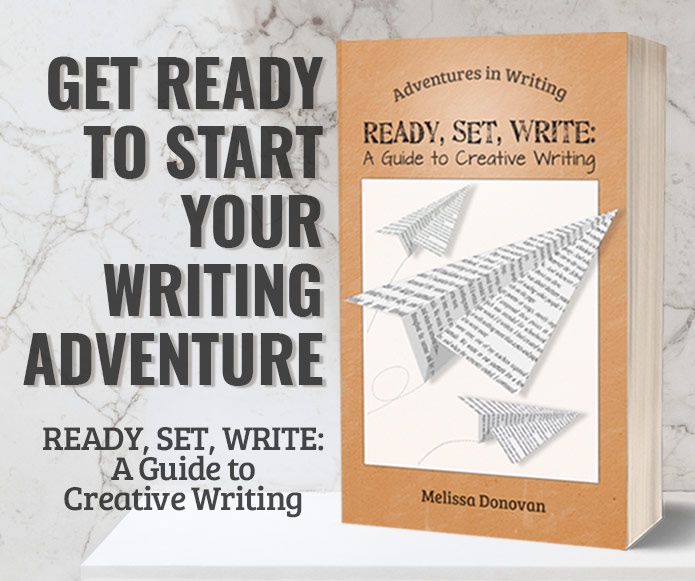Rhythm is everywhere: we hear it in the hum of vehicles and appliances. We feel it when we walk or run. We see it in the very rising and setting of the sun. Even our hearts beat to a rhythm. Rhythm is built into the way we experience and perceive the world.
Merriam-Webster’s Dictionary offers several definitions for rhythm:
- an ordered recurrent alternation of strong and weak elements in the flow of sound and silence in speech
Poetry encapsulates all of these definitions of rhythm. But what about meter?
The words rhythm and meter are often used interchangeably, but their meanings are slightly different in the context of poetry. Perinne’s Sound and Sense (aff link) describes this difference clearly and simply: “rhythm is the flow of sound; meter is the patterns in the sounds.”
Scansion
In poetry, meter is determined by accented (stressed) and unaccented (unstressed) syllables. Silence (or pauses) also contributes to a poem’s meter. Scansion is the practice of marking up a poem to reveal its meter. Here is a traditional method of marking up a poem, using Edgar Allan Poe’s “Annabel Lee” as an example: The character that looks like the bottom half of a circle is called a breve. The breve indicates unstressed syllables, and the slash indicates stressed syllables. You won’t find the breve on your keyboard, but it is available in Microsoft Word by using the Insert –> Symbol function.
The character that looks like the bottom half of a circle is called a breve. The breve indicates unstressed syllables, and the slash indicates stressed syllables. You won’t find the breve on your keyboard, but it is available in Microsoft Word by using the Insert –> Symbol function.
However, working with breves and slashes on a computer in this manner is tedious and time consuming. Fortunately, there are some other methods available to us.
Some dictionaries include pronunciation guides, which indicate stressed and unstressed syllables. Dictionaries often use quotation marks for stressed syllables and apostrophes for unstressed syllables: PO”e’try’. This isn’t easy on the eyes. Another option, which is much clearer, is to use all caps for stressed syllables and all lowercase letters for unstressed syllables: POetry; and we can add hyphens to further denote each syllable: PO-e-try. Ah, that’s more like it: easy to read and easy to type.
Metrical Units
We now know how to show meter with scansion, but we also need to know how to talk about it. Here is some special terminology that helps us communicate when discussing meter:
A metrical foot is a unit of metrical measurement that includes stressed and unstressed syllables. Here are a few types of metrical feet:
- Anapest: Two unstressed syllables followed by a stressed syllable (da-da-DA). Example: un-der-STAND.
- Dactyl: One stressed syllable followed by two unstressed syllables (DA-da-da). Example: PROM-i-nent.
- Iamb: One unstressed syllable followed by one stressed syllable (da-DA). Example: be-LONG
- Trochee: One stressed syllable followed by one unstressed syllable (DA-da). Example: O-ver
We also use special terminology to refer to the number of feet in a line of poetry:
- 1 foot: monometer
- 2 feet: dimeter
- 3 feet: trimeter
- 4 feet: tetrameter
- 5 feet: pentameter
Let’s return to the first line of “Annabel Lee” and show its metrical feet:
it was MA|ny and MA|ny a YEAR | aGO ||
This line consists of three anapests followed by an iamb, or a combination of anapestic and iambic feet.
But what about the number of feet? How do those factor into the language we use to talk about meter? Let’s look at a line from Shakespeare’s “Sonnet 18” (please note that I have changed the capitalization to accommodate scansion):
shall I | comPARE | thee TO | a SUM | mer’s DAY? ||
Thou ART | more LOVE | ly AND | more TEM | perATE:
Each line consists of five metrical feet, so this poem is written in pentameter. Each line also includes five iambs. These lines are therefore written in iambic pentameter.
Silence (Rests, Pauses)
In poetry, line breaks, stanza breaks, white space, and punctuation provide cues for pauses. We’ll pause a little longer between stanzas than we will between lines. We’ll hold on a period longer than on a comma. Sometimes breaks and punctuation are part of the aesthetic design of a poem, but their placement will almost always affect a poem’s meter and rhythm, because they instruct the reader to pause.
End-stopped lines contain a complete grammatical phrase (or clause) or terminate with a period, closing parenthesis, colon, or semicolon. Enjambment occurs when a line break occurs in the middle of a complete phrase or clause or when terminal punctuation marks are absent. The first two lines of “Annabel Lee” (above) are enjambed; the first two lines of “Sonnet 18” (above) are end-stopped.
Let’s Get Back to Rhythm
Rhythm is best understood as the flow of sound, whereas meter is a pattern of sound. If we mistakenly equate rhythm and meter, we might assume that free verse poetry lacks rhythm because it doesn’t use metrical patterns. Let’s look at the first stanza of “Spelling” by Margaret Atwood, which is written in free verse:
My daughter plays on the floor
with plastic letters,
red, blue & hard yellow,
learning how to spell,
spelling,
how to make spells.
There’s no discernible pattern in the meter, which is why the poem is called free verse. Yet the poem still has a flow, a rhythm. If the rhythm isn’t coming from the poem’s meter, where is it coming from?
Even though there aren’t repeated patterns, the accented and unaccented syllables still inform the rhythm. But so do the pauses. Consider the pause after “spelling” and before “how to make spells.” This pause influences the musicality of the poem. But the poem uses some other tricks to create rhythm. Look at the rhyme of “yellow” and “spell” (not a perfect rhyme, but a rhyme nonetheless). And look at how it echoes into the next two lines with “spelling” and the repetition of “spell(s)” in the final line. There’s a pattern of sound there, which creates rhythm.
As we can see, meter is not the only contributing factor to rhythm.
How Rhythmical is Your Poetry?
If meter is a pattern of sounds and rhythm is the flow of sound, which of these elements is more important in poetry? When you write poetry, do you check for meter or rhythm? Do you prefer metrical poems or are you drawn to poems with vivid rhythm? Share your thoughts by leaving a comment, and keep writing poetry!





Very informative. Thanks!
You’re welcome!
Oh thank you! I am old school when it comes to poetry – it has to have either meter or rhyme or else it is just prose chopped up into short sentences. Of course that’s just my opinion…
You’re welcome, Grace. I’m glad you liked this post.
And I 100% agree with you, Grace. Your words about prose being chopped up onto lines are the exact words I use myself.
And as someone who has written poetry, both rhyming and not, it is harder to write rhyming poetry that has rhythm than breaking a piece of prose, no matter how beautiful and poetic, into seemingly random lines.
Thank you very much for this article. Very useful in teaching my subject in Literature.
You’re welcome, Avelina.
lol we had to read this for a school assigment
Same
Well, I don’t know how you feel about it, but it’s pretty cool for me! I hope your class was able to learn something from it.
i learn a lot thanks
Fabulous demonstration, but I had a doubt about finding stressed and unstressed syllables in monosyllabic words: by, and, I, sea, year and so on…if this can be clarified, thank you!
Hi Omar. I’m not sure what you mean about having “a doubt about finding stressed and unstressed syllables in monosyllabic words.” Feel free to clarify, and I’ll try to answer.
Thank you for this. It was most interesting. I’ve heard about iambic pentameter, but never really knew what it is.
But I can’t see any rhyme between yellow and spell.
I believe the rhyme is within *yell*-ow and *spell*-space.
Thank you! This was most helpful. Am writing a paper on intersemiotic translation based on a visual poetry film I made, and needed clarity on this.
You’re welcome, and thanks for sending the tip about the correction 😉
For me, a poem fully exists when it is read aloud, felt in the body. I find metrical poetry easier to fit into the rhythms of breathing and also easier to prepare for reading aloud (principally by identifying beats, metrical irregularities, significant pauses and run-on lines). Non-metrical poetry _seems_ more difficult, not having familiar structures to identify and hang onto, but perhaps it’s easier: maybe you can identify what syllables would be stressed in normal speech and then make the pauses at the end of the line of a length that seems to help the succession of thoughts.
I wonder if you meant to refer to rhythmic poetry? Meter is a method for measuring stressed and unstressed syllables.